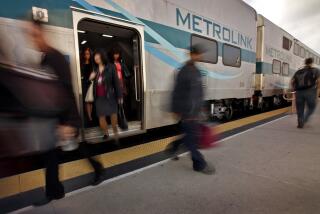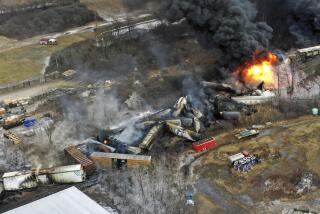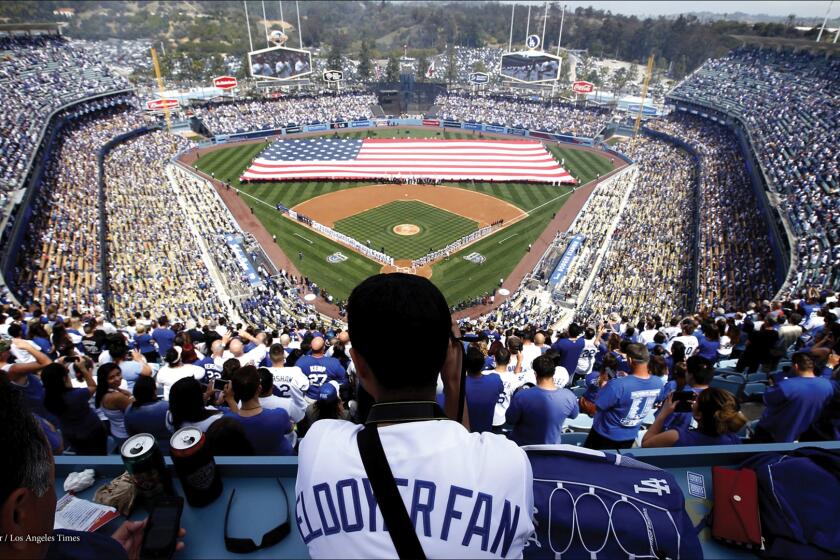Train Crash Light At Issue
- Share via
A critical red light that a Metrolink train ran just before slamming into a freight train in Chatsworth was not as visible as green and yellow signals displayed by the same trackside warning device, investigators probing the disaster have found.
The clarity of the stop light, as well as possible violations of communication rules by the commuter train’s crew, have become key focus points in the federal inquiry into the deadliest rail accident in modern California history.
“We did some signal inspections. Can’t hardly see the red,” one investigator told another just before the pair ducked into a closed-door briefing three days after the Sept. 12 crash. Now, similar observations have gained acceptance among investigators in the multi-agency inquiry, which is being led by the National Transportation Safety Board.
“It was the unanimous consensus of the investigative team that the red was not as illuminated or clear or clearly lit,” said one knowledgeable source who requested anonymity because of restrictions on comments about the inquiry.
The reasons for the difference in visibility and what, if any, role it played in the crash could shed light on the central mystery of the catastrophe: Why did a veteran engineer barrel through a stop light that officials say should have been visible from a mile away?
Most public attention after the crash, which killed 25 and injured 135, focused on dozens of cellphone text messages received and sent by Metrolink engineer Robert M. Sanchez, who was also killed. One message was sent only 22 seconds before his train rammed into a Union Pacific freight train. It is unclear if a signal problem would reduce his potential responsibility for the crash.
NTSB officials note that train collisions normally have more than one cause. Agency investigators returned to Chatsworth in November to review signals and interview witnesses, The Times has learned.
A number of factors could have caused the red signal to be less bright, including circuit problems that reduce voltage to the bulb, according to experts who have investigated signal malfunctions.
“It happens from time to time, but not very often,” said Bill Perry, a former Federal Railroad Administration signal inspector.
Metrolink has declined to comment on the investigation. But as part of a sweeping safety review after the crash, the agency’s governing board accelerated a program to install hundreds more visible signal bulbs. No changes have been made thus far to the signal near the collision site, an agency spokesman said last week.
Experts say that text messaging, coupled with a light that was less clearly visible, could have caused a high level of “inattention blindness,” resulting in Sanchez’s failure to notice the warning signal.
“Your eyes are looking at it, but you don’t see it,” said David Strayer, a University of Utah psychology professor who has researched how using wireless communication devices affects motorists.
Failure to comply with trackside signals is a leading cause of rail accidents. On Nov. 20, a Metrolink train engineer went through a red light in Rialto and hit a freight train, injuring five passengers.
Part of the Chatsworth probe is zeroing in on a possible violation of a decade-old communication procedure intended to prevent signal-running collisions.
Engineers are required to call out via radio all signal colors and their locations as they become visible. Conductors, who typically ride several cars away from the engineer, are required to confirm all yellow or red signals -- those requiring the engineer to slow down or stop.
The importance of the practice was underscored last month when Metrolink tightened procedures after the Chatsworth crash. Engineers and conductors now must stop trains -- if necessary, using the emergency brake -- when one of them fails to call out or confirm a signal color. Previously, crew members were required to stop the train only after a stop or speed restriction was violated.
Announcing and acknowledging signals over the radio serves as an extra safety check for crew members, and it also alerts nearby trains that another vehicle is in the area, experts say.
“They are required to call those signals so they [all] are aware of what’s coming,” said former engineer Tim Smith, California chairman of the union that represented Sanchez. “It puts it on the entire crew, to understand the movement of the train.”
Back-to-back train crashes in 1996 prompted new federal rules for passenger train crews to call out signals. The Maryland and New Jersey accidents, which together killed 12 people and injured 175, occurred after engineers ran red stop lights.
Before ramming the freight train in Chatsworth, the Metrolink engineer encountered three signals, all of which were working properly, according to the NTSB.
The first was about a mile south of the Metrolink station. It was flashing yellow, alerting Sanchez to slow down, investigators say. Under Metrolink policy, Sanchez and conductor Robert Heldenbrand, who was injured, were required to confirm the color of the light.
It is not clear if they did.
A few days after the crash, NTSB board member Kitty Higgins told reporters that preliminary evidence suggested that the two men had properly called out that signal. But in response to a recent question from The Times, she said she was later told that the engineer can be heard announcing the signal on a recording of the train’s radio transmissions -- however, the conductor may not have confirmed it.
The second signal that Sanchez passed, closer to the Chatsworth station, was solid yellow, a warning that a key light just beyond the station was red, according to federal investigators.
The third signal, which officials say was red, was about a mile north of the depot, where a side railing merges with the main track on which freight traffic also runs. The light could be seen from the station, investigators say.
After stopping at the station, Sanchez was required to radio information about the signal when it became visible. Heldenbrand would have been required to confirm it.
But the conductor told federal investigators that he and Sanchez did not communicate about the final two lights, Higgins said.
“Why it wasn’t done for the last two signals, I don’t know,” she told reporters.
Heldenbrand, contacted recently, declined to speak to The Times. He said he was prohibited from talking to reporters by his employer, a subcontractor owned by Veolia Transportation, which provides Metrolink engineers and conductors. Complicating questions about the signals, a station security guard and two other witnesses insist that the final light was green as Sanchez pulled out of the station and headed toward the crash site.
The three men, whose accounts previously were reported by The Times, were formally interviewed by NTSB investigators last month at the station. Investigators tested their ability to see the critical signal, one of the witnesses recalled.
“They asked on a percentage basis how sure I was it was green,” said Chris Cassel, a train buff who regularly monitors arrivals, departures and signals near the station. “I told them a bazillion percent. There’s no doubt.”
Some of the Metrolink crew’s actions appear consistent with a belief the light was green. Sanchez, for instance, accelerated to 54 mph after he pulled out of the station. If the final light was red, he would have been required to stay under 40 mph. Also, if the light was green, Heldenbrand would not have been required to confirm the color with the engineer.
Safety records obtained by The Times under the California Public Records Act show that Sanchez and Heldenbrand, who regularly worked together, passed Metrolink safety reviews in the eight months before the crash.
The records are part of a mountain of evidence investigators are reviewing as they analyze the signals, the actions of the Metrolink crew, and whether the current signal-calling and other procedures are adequate.
“The question,” Higgins told reporters after the crash, “is did [Sanchez] see it red?
“Did he see it as something else? Did he see it at all?”
--
robert.lopez@latimes.com
More to Read
Sign up for Essential California
The most important California stories and recommendations in your inbox every morning.
You may occasionally receive promotional content from the Los Angeles Times.














